Tunability of the Nonlinear Interferometer Method for Anchoring Constructive Interference Patterns on the ITU-T Grid
Abstract
1. Introduction
2. Measurement Setup
3. Results
3.1. Pump Wavelength
3.2. Length of Nonlinear Pair Generation Medium
3.3. Length of Linear Dispersive Medium
3.4. Number of Stages
3.5. Cooling
4. Conclusions
Author Contributions
Funding
Institutional Review Board Statement
Informed Consent Statement
Data Availability Statement
Conflicts of Interest
References
- Bouwmeester, D.; Pan, J.; Klaus, M.; Manfred, E.; Harald, W.; Anton, Z. Experimental quantum teleportation. Nature 1997, 403, 575–579. [Google Scholar] [CrossRef]
- Knill, E.; Laflamme, R.; Milburn, G.J. A scheme for efficient quantum computation with linear optics. Nature 2001, 409, 46–52. [Google Scholar] [CrossRef]
- Hong, C.; Mandel, L. Experimental realization of a localized one-photon state. Phys. Rev. Lett. 1986, 56, 58–60. [Google Scholar] [CrossRef]
- Grice, W.P.; Walmsley, I.A. Spectral information and distinguishability in type-II down-conversion with a broadband pump. Phys. Rev. A 1997, 56, 1627. [Google Scholar] [CrossRef]
- Grice, W.P.; U’Ren, A.B.; Walmsley, I.A. Eliminating frequency and space-time correlations in multiphoton states. Phys. Rev. A 2001, 64, 063815. [Google Scholar] [CrossRef]
- Ou, Z.Y.; Rhee, J.K.; Wang, L.J. Photon bunching and multiphoton interference in parametric down-conversion. Phys. Rev. A 1999, 60, 593. [Google Scholar] [CrossRef]
- Brańczyk, A.M.; Ralph, T.C.; Helwig, W.; Silberhorn, C. Optimized generation of heralded Fock states using parametric down-conversion. New J. Phys. 2010, 12, 063001. [Google Scholar] [CrossRef]
- Garay-Palmett, K.; McGuinness, H.J.; Cohen, O.; Lundeen, J.S.; Rangel-Rojo, R.; U’Ren, A.B.; Raymer, M.G.; McKinstrie, C.J.; Radic, S.; Walmsley, I.A. Photon pair-state preparation with tailored spectral properties by spontaneous four-wave mixing in photonic-crystal fiber. Opt. Express 2007, 15, 14870–14886. [Google Scholar] [CrossRef] [PubMed]
- Mosley, P.J.; Lundeen, J.S.; Smith, B.J.; Wasylczyk, P.; U’Ren, A.B.; Silberhorn, C.; Walmsley, I.A. Heralded generation of ultrafast single photons in pure quantum states. Phys. Rev. Lett. 2008, 100, 133601. [Google Scholar] [CrossRef]
- Brańczyk, A.M.; Fedrizzi, A.; Stace, T.M.; Ralph, T.C.; White, A.G. Engineered optical nonlinearity for quantum light sources. Opt. Express 2011, 19, 55–65. [Google Scholar] [CrossRef]
- Dosseva, A.; Cincio, Ł.; Brańczyk, A.M. Shaping the joint spectrum of down-converted photons through optimized custom poling. Phys. Rev. A 2016, 93, 013801. [Google Scholar] [CrossRef]
- Chen, C.; Bo, C.; Niu, M.Y.; Xu, F.; Zhang, Z.; Shapiro, J.H.; Wong, F.N.C. Efficient generation and characterization of spectrally factorable biphotons. Opt. Express 2017, 25, 7300–7312. [Google Scholar] [CrossRef]
- Halder, M.; Fulconis, J.; Cemlyn, C.; Clark, A.; Xiong, C.; Wadsworth, W.J.; Rarity, J.G. Nonclassical 2-photon interference with separate intrinsically narrowband fibre sources. Opt. Express 2009, 17, 4670–4676. [Google Scholar] [CrossRef]
- Cohen, O.; Lundeen, J.S.; Smith, B.J.; Puentes, G.; Mosley, P.J.; Walmsley, I.A. Tailored photon-pair generation in optical fibers. Phys. Rev. Lett. 2009, 102, 123603. [Google Scholar] [CrossRef]
- Smith, B.J.; Mahou, P.; Cohen, O.; Lundeen, J.S.; Walmsley, I.A. Photon pair generation in birefringent optical fibers. Opt. Express 2009, 17, 23589–23602. [Google Scholar] [CrossRef]
- Cui, L.; Li, X.; Zhao, N. Minimizing the frequency correlation of photon pairs in photonic crystal fibers. New J. Phys. 2012, 14, 123001. [Google Scholar] [CrossRef][Green Version]
- Fang, B.; Cohen, O.; Moreno, J.B.; Lorenz, V.O. State engineering of photon pairs produced through dual-pump spontaneous four-wave mixing. Opt. Express 2013, 21, 2707–2717. [Google Scholar] [CrossRef] [PubMed]
- Cui, L.; Su, J.; Li, J.; Liu, Y.; Li, X.; Ou, Z.Y. Quantum state engineering by nonlinear quantum interference. Phys. Rev. A 2020, 102, 033718. [Google Scholar] [CrossRef]
- Su, J.; Cui, L.; Li, J.; Liu, Y.; Li, X.; Ou, Z.Y. Versatile and precise quantum state engineering by using nonlinear interferometers. Opt. Express 2019, 27, 20479–20492. [Google Scholar] [CrossRef] [PubMed]
- Li, J.; Su, J.; Cui, L.; Xie, T.; Ou, Z.Y.; Li, X. Generation of pure-state single photons with high heralding efficiency by using a three-stage nonlinear interferometer. Appl. Phy. Lett. 2020, 116, 204002. [Google Scholar] [CrossRef]
- Park, K.; Lee, D.; Boyd, R.W.; Shin, H. Telecom C-band Photon-Pair Generation using Standard SMF-28 Fiber. Opt. Commun. 2021, 484, 126692. [Google Scholar] [CrossRef]
- Zielnicki, K.; Garay-Palmett, K.; Cruz-Delgado, D.; Cruz-Ramirez, H.; O’Boyle, M.F.; Fang, B.; Lorenz, V.O.; U’Ren, A.B.; Kwiat, P.G. Joint spectral characterization of photon-pair sources. J. Mod. Opt. 2018, 65, 1141–1160. [Google Scholar] [CrossRef]
- Berkovic, G.; Shafir, E. Optical methods for distance and displacement measurements. Adv. Opt. Photonics 2012, 4, 441–471. [Google Scholar] [CrossRef]
- Park, K.; Lee, D.; Ihn, Y.S.; Kim, Y.-H.; Shin, H. Observation of photon-pair generation in the normal group-velocity-dispersion regime with slight detuning from the pump wavelength. New J. Phys. 2018, 20, 103004. [Google Scholar] [CrossRef]
- Takesue, H.; Inoue, K. 1.5-μm band quantum-correlated photon pair generation in dispersion-shifted fiber: Suppression of noise photons by cooling fiber. Opt. Express 2005, 13, 7832. [Google Scholar] [CrossRef] [PubMed]
- Dyer, S.D.; Stevens, M.J.; Baek, B.; Nam, S.W. High-efficiency, ultra low-noise all-fiber photon-pair source. Opt. Express 2008, 16, 9966–9977. [Google Scholar] [CrossRef]

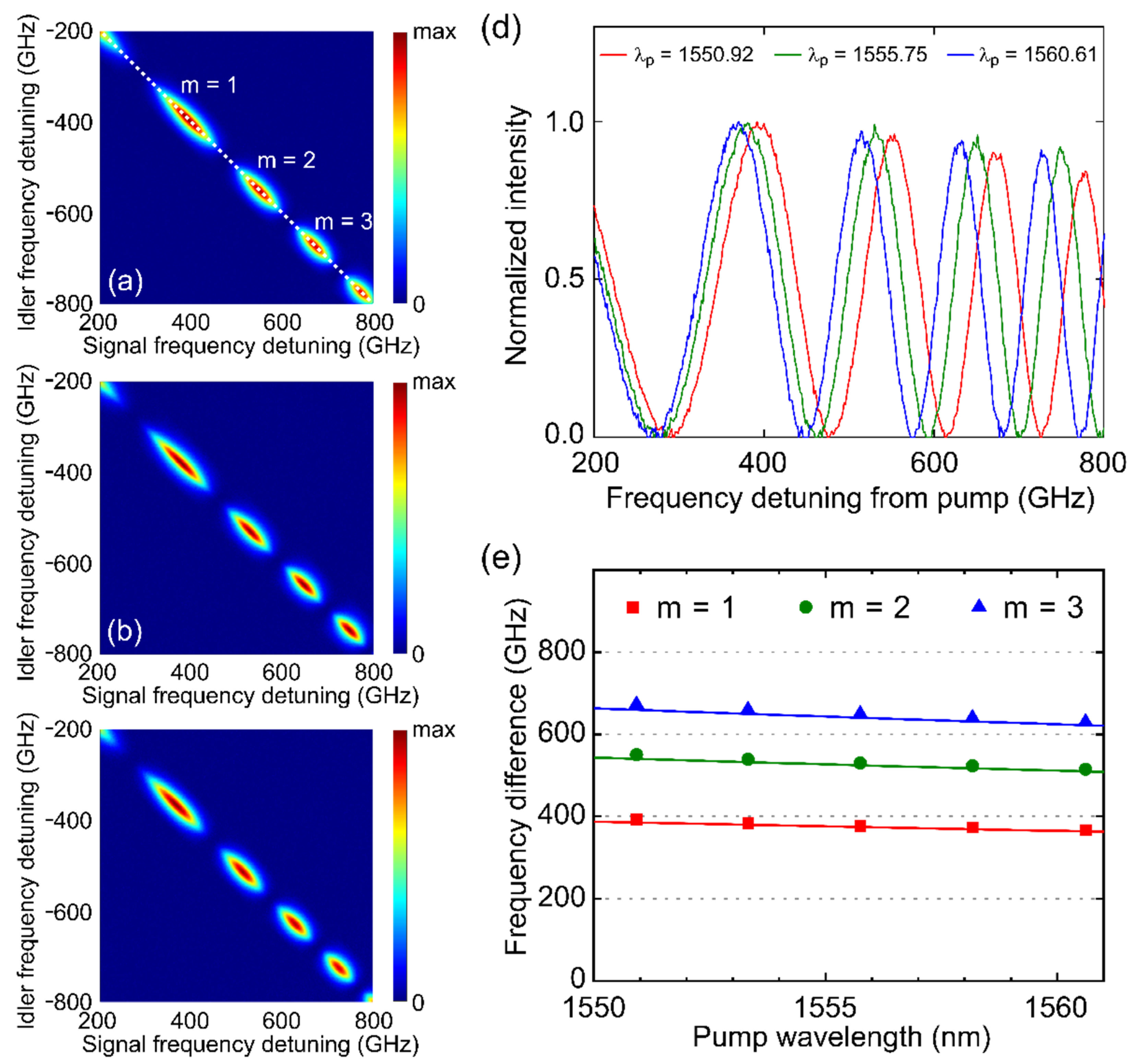
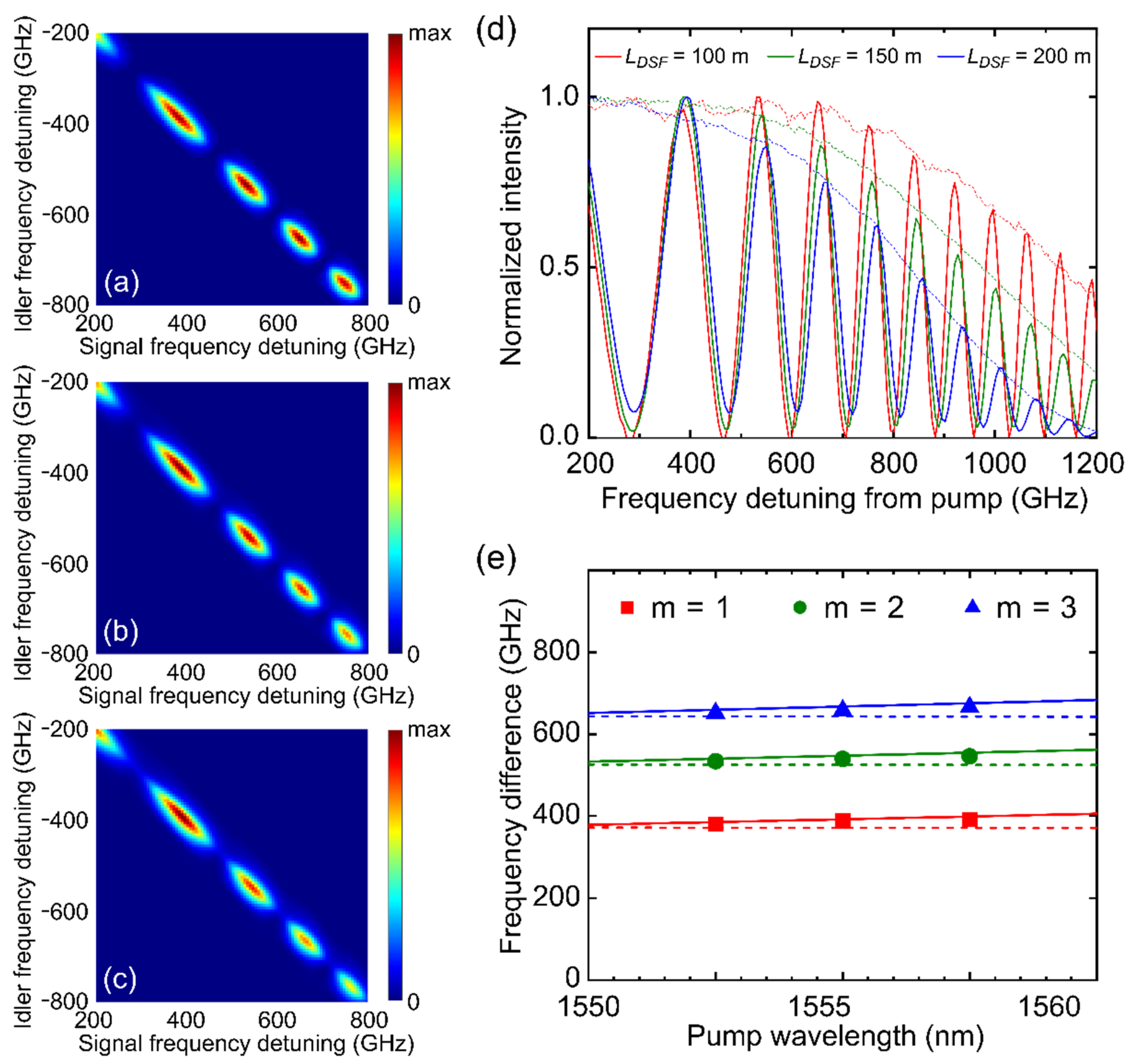
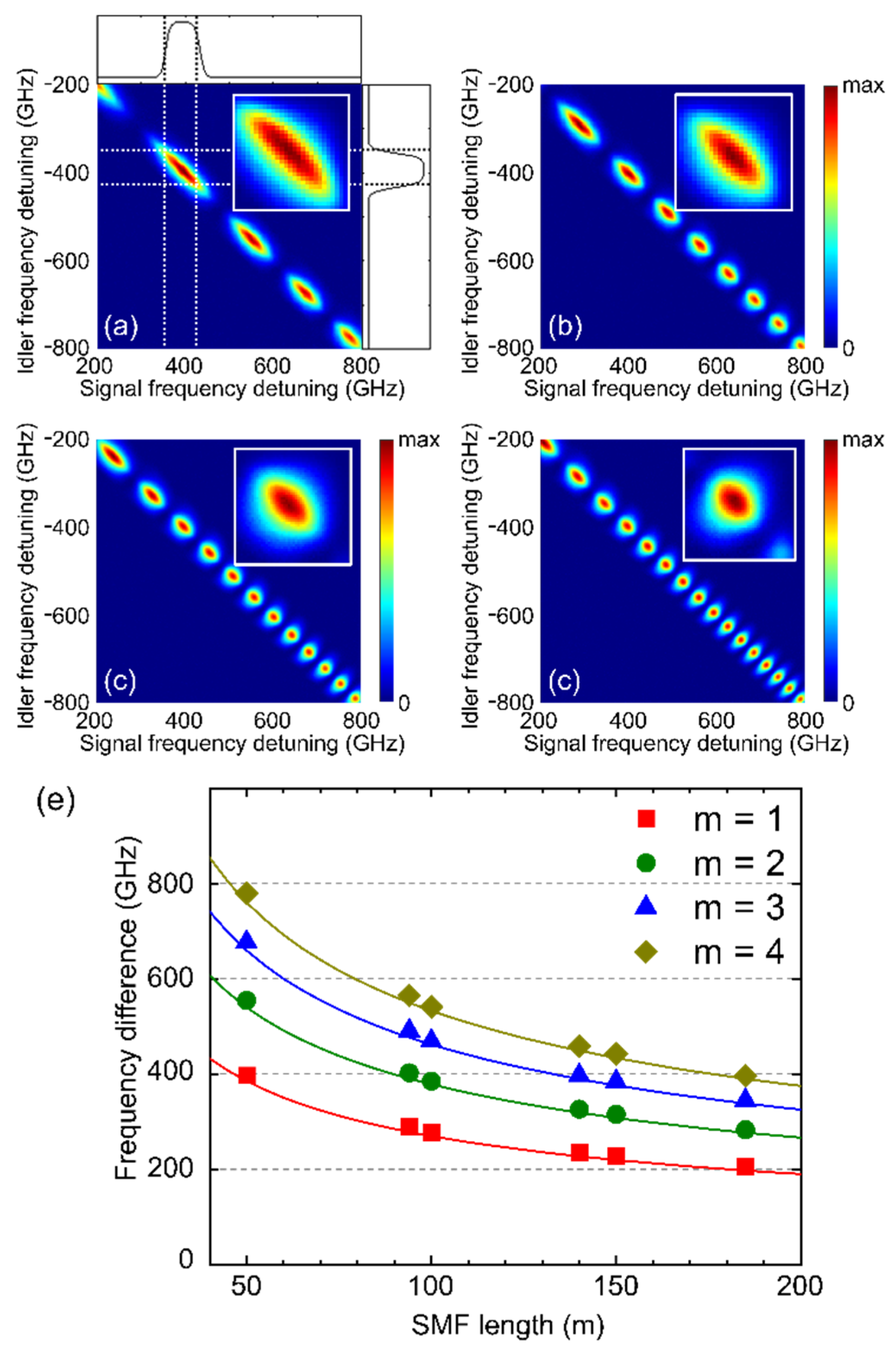
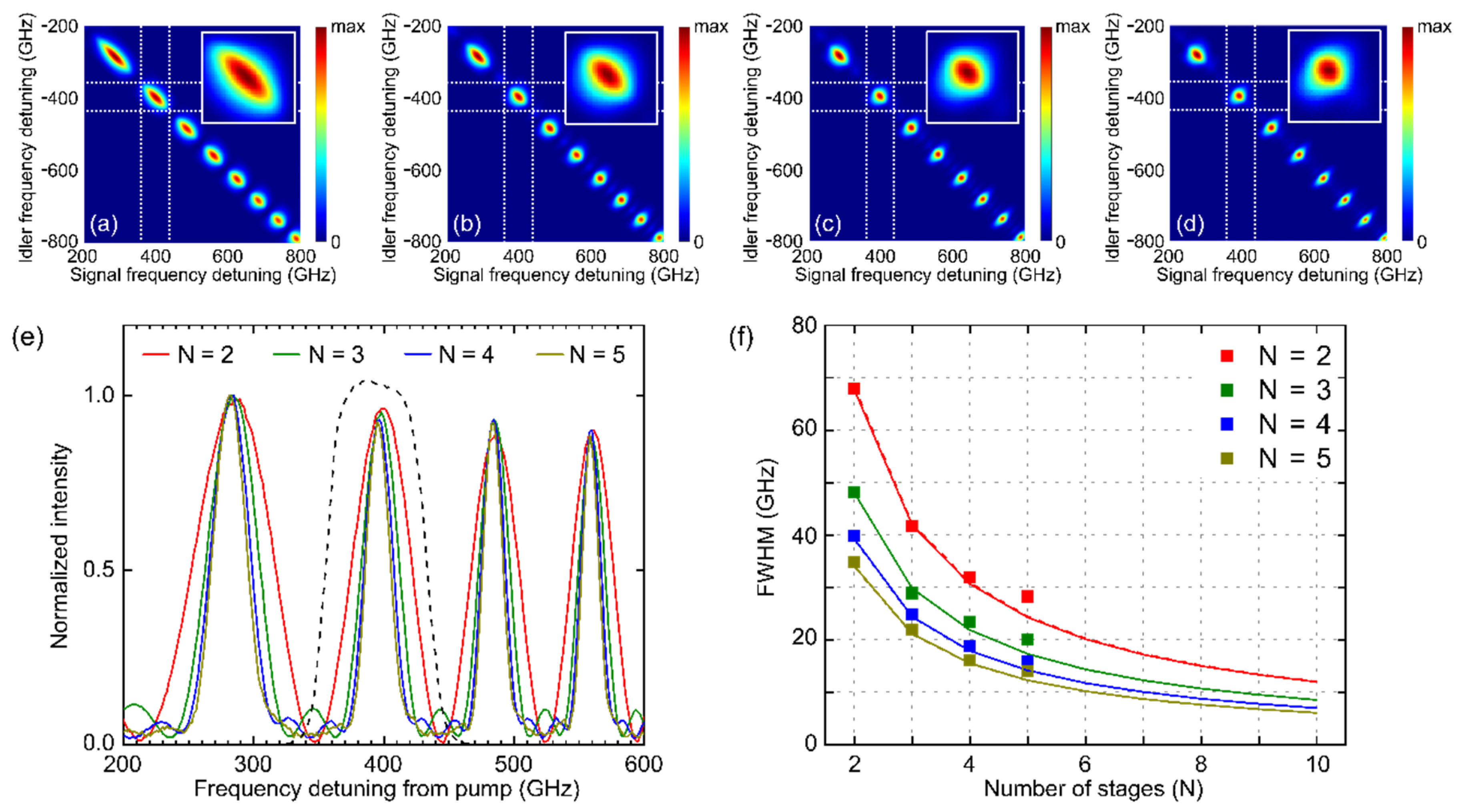
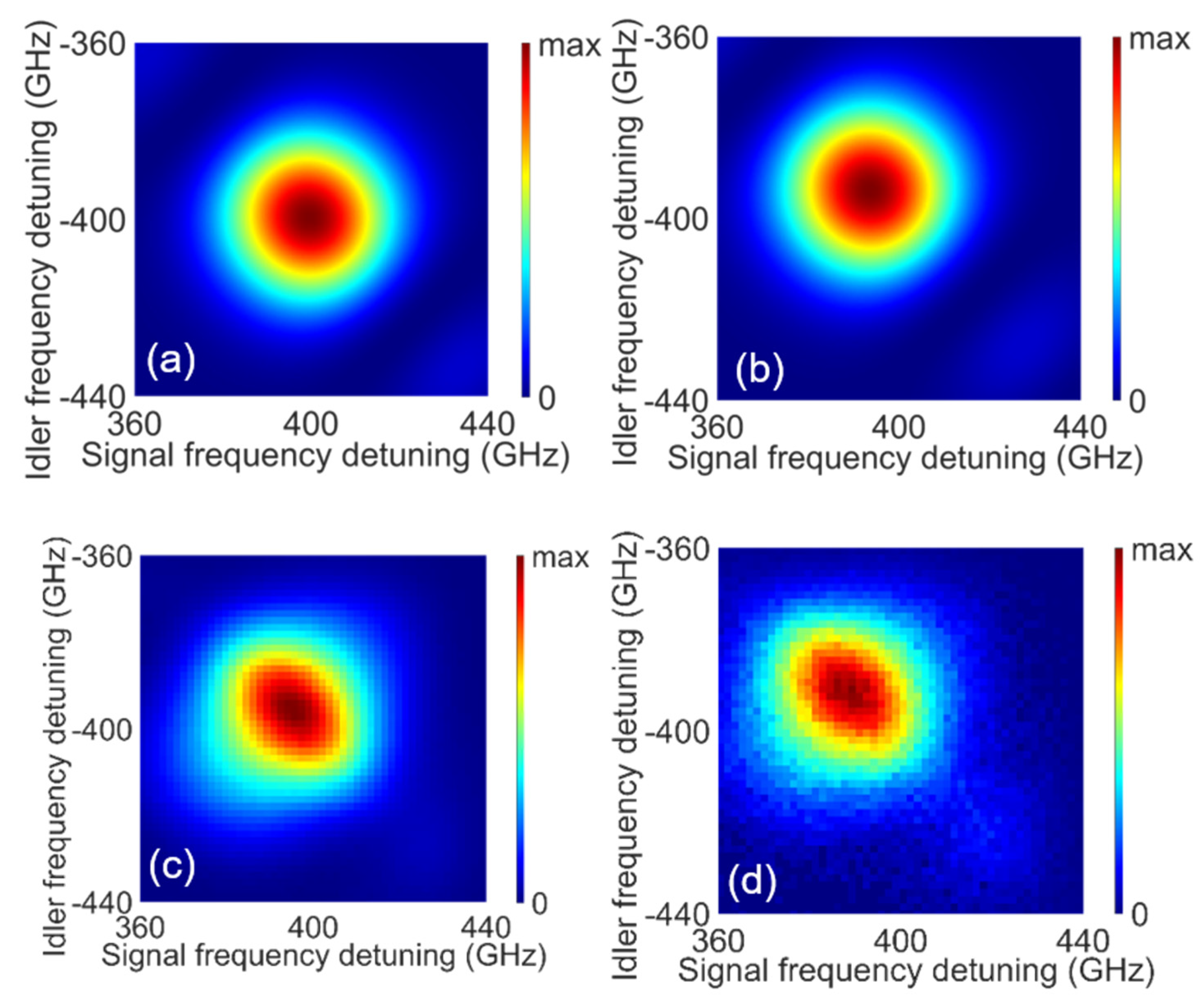
Publisher’s Note: MDPI stays neutral with regard to jurisdictional claims in published maps and institutional affiliations. |
© 2021 by the authors. Licensee MDPI, Basel, Switzerland. This article is an open access article distributed under the terms and conditions of the Creative Commons Attribution (CC BY) license (http://creativecommons.org/licenses/by/4.0/).
Share and Cite
Park, K.; Lee, D.; Shin, H. Tunability of the Nonlinear Interferometer Method for Anchoring Constructive Interference Patterns on the ITU-T Grid. Appl. Sci. 2021, 11, 1429. https://doi.org/10.3390/app11041429
Park K, Lee D, Shin H. Tunability of the Nonlinear Interferometer Method for Anchoring Constructive Interference Patterns on the ITU-T Grid. Applied Sciences. 2021; 11(4):1429. https://doi.org/10.3390/app11041429
Chicago/Turabian StylePark, Kyungdeuk, Dongjin Lee, and Heedeuk Shin. 2021. "Tunability of the Nonlinear Interferometer Method for Anchoring Constructive Interference Patterns on the ITU-T Grid" Applied Sciences 11, no. 4: 1429. https://doi.org/10.3390/app11041429
APA StylePark, K., Lee, D., & Shin, H. (2021). Tunability of the Nonlinear Interferometer Method for Anchoring Constructive Interference Patterns on the ITU-T Grid. Applied Sciences, 11(4), 1429. https://doi.org/10.3390/app11041429





